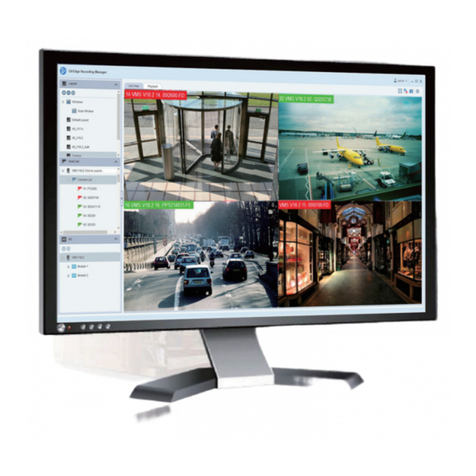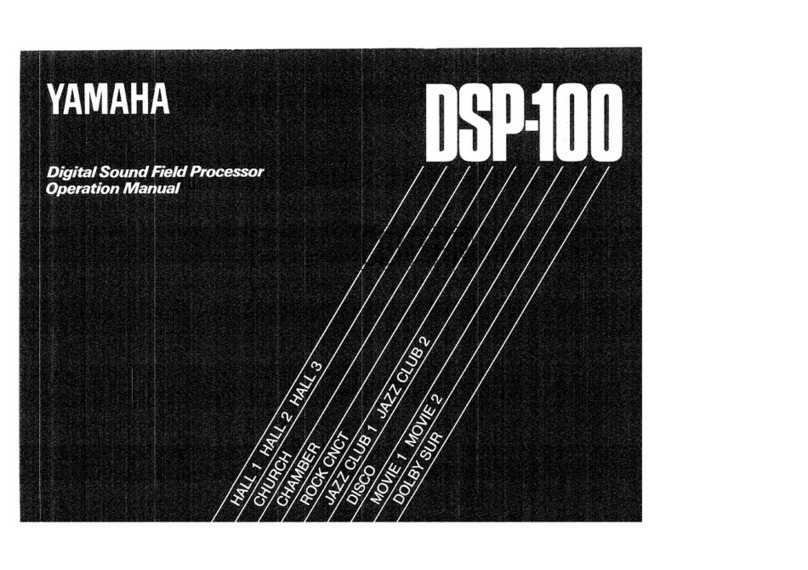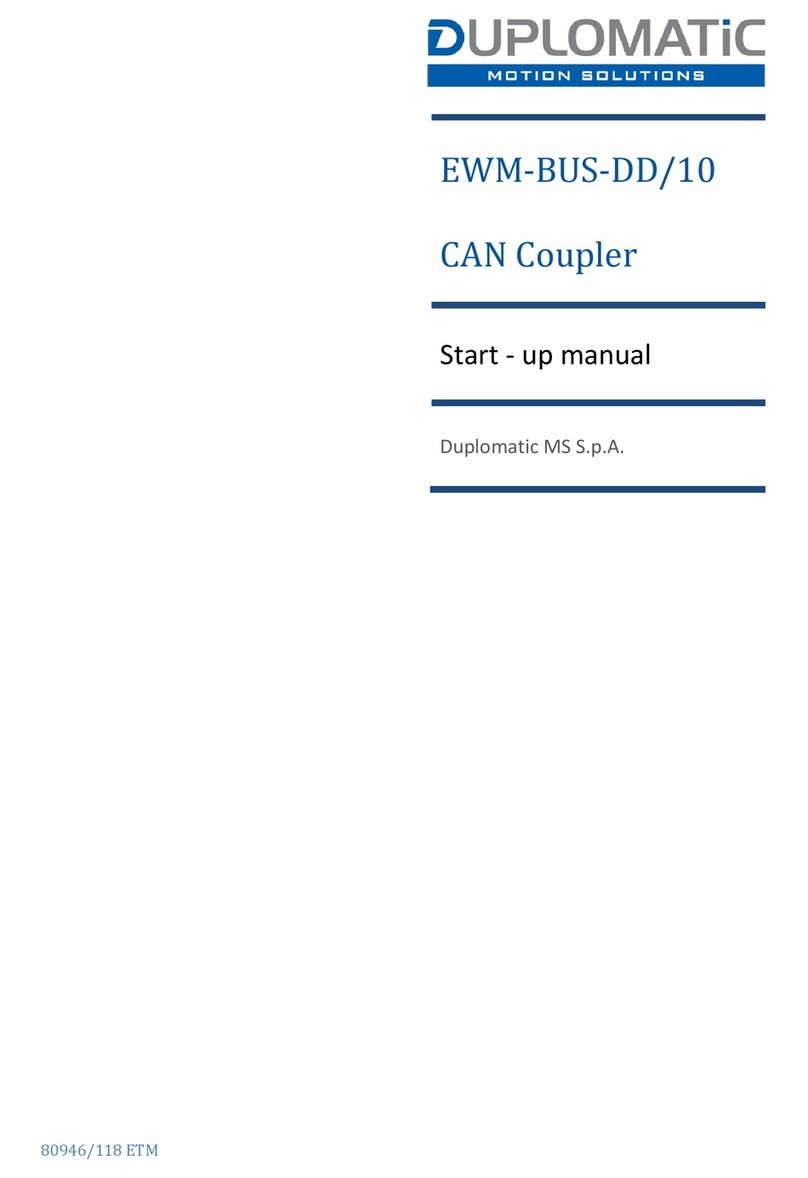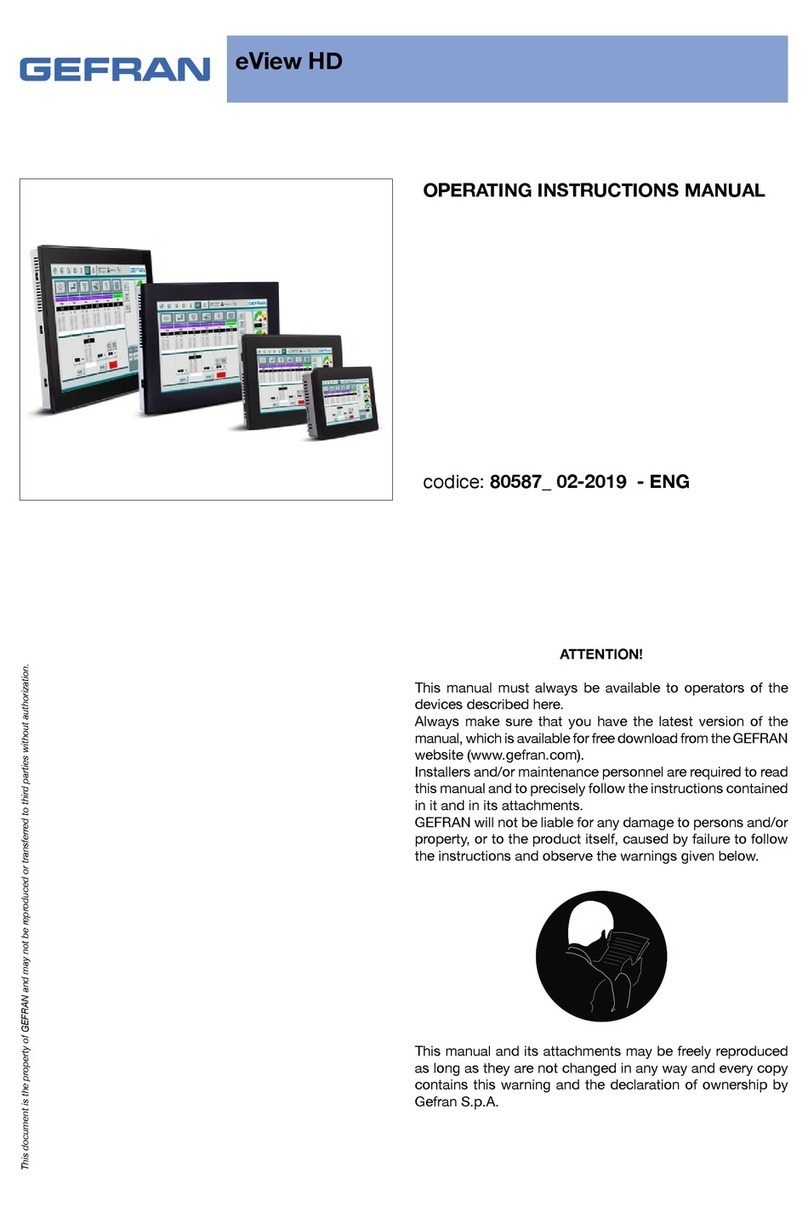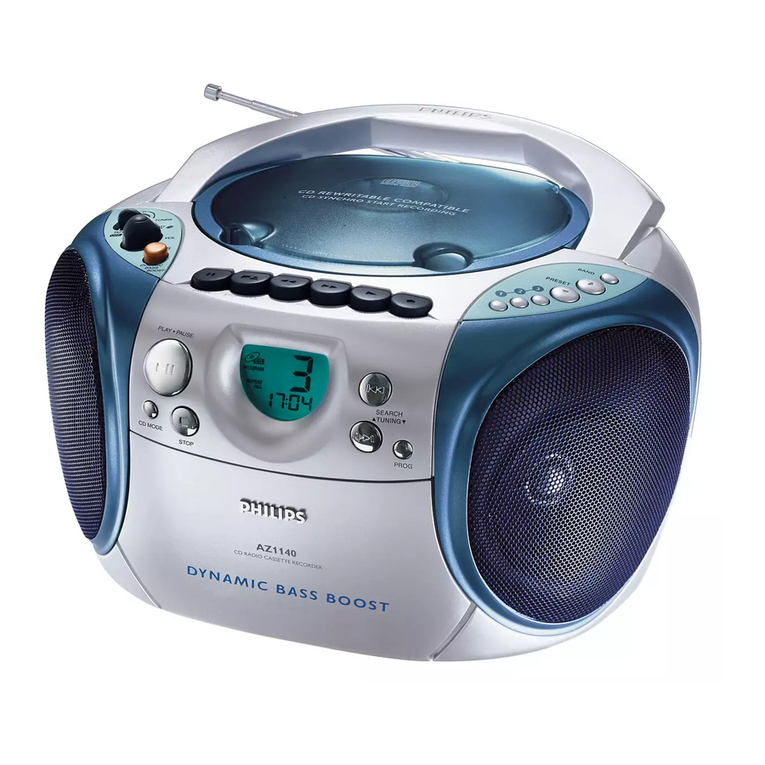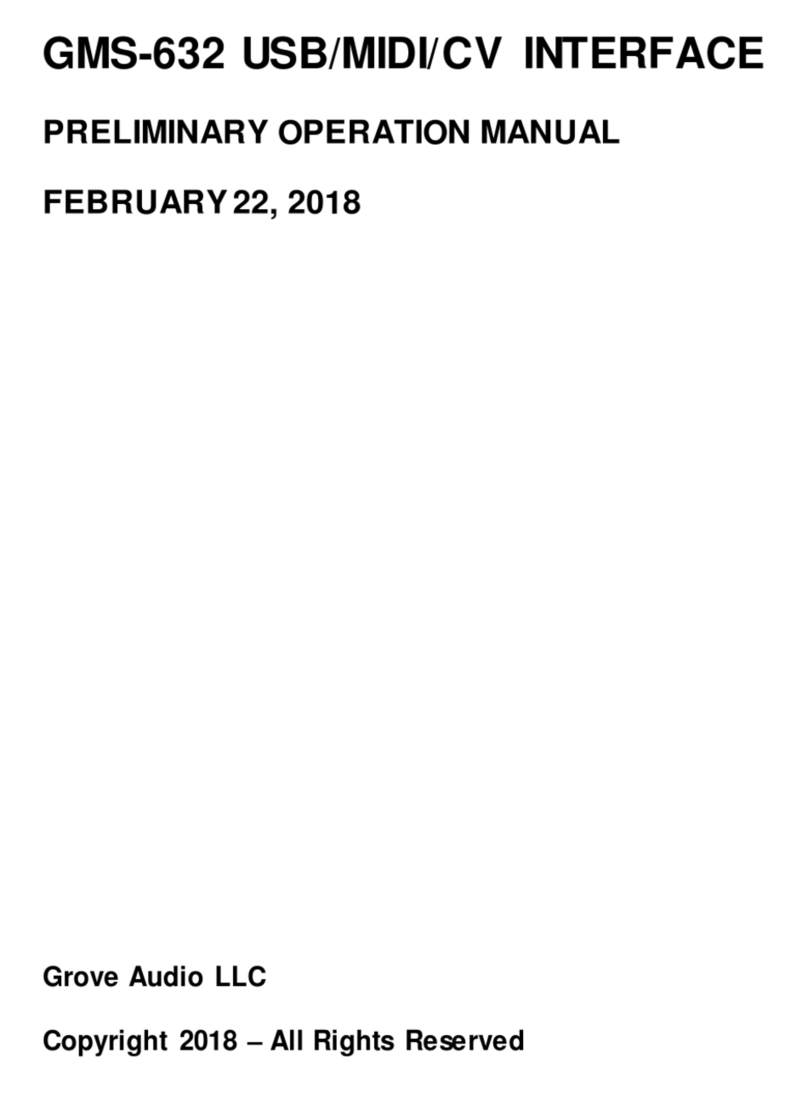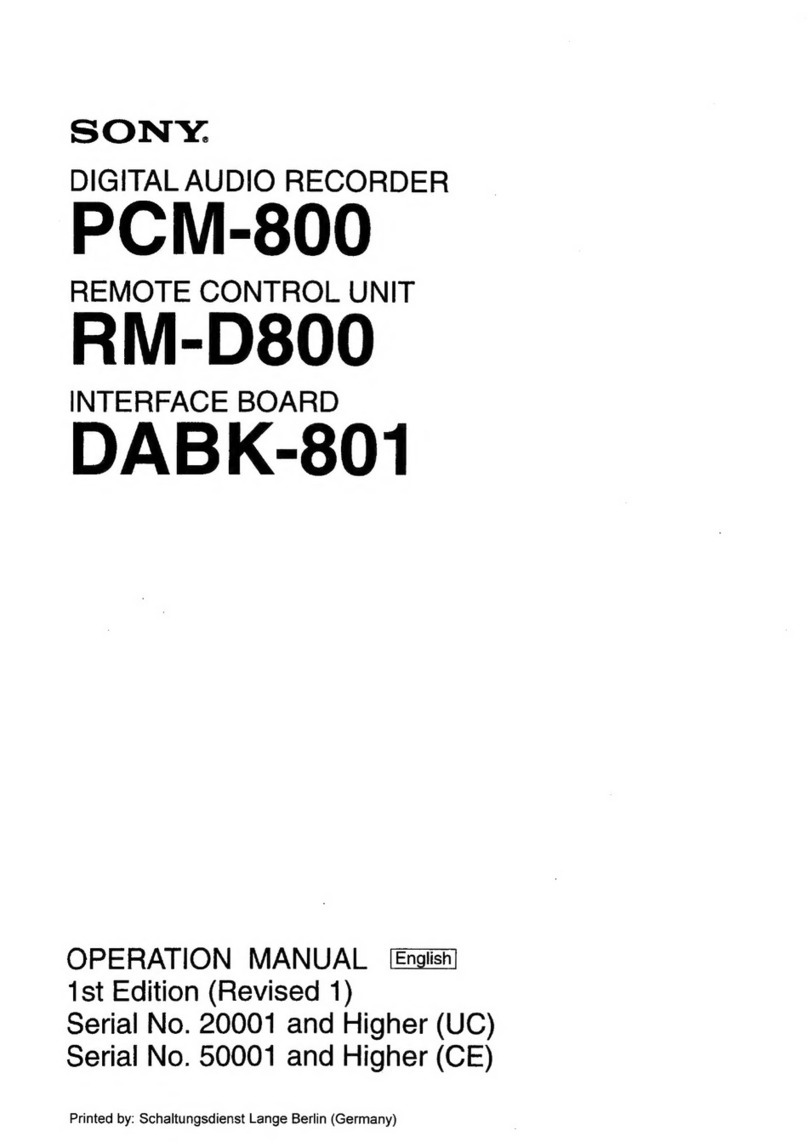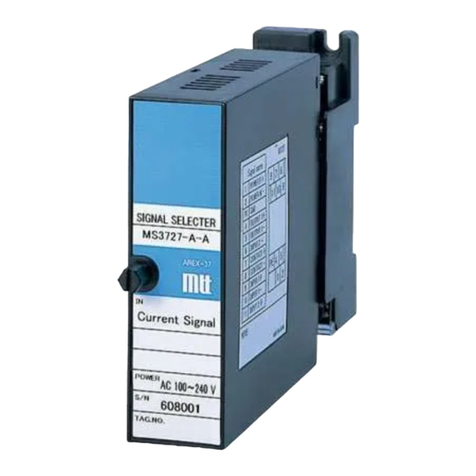Dedicated Mircros Digital Sprite 2 Installation and operating instructions

Setup Guide Addendum
New features and amendments for DS2 models with built in CDR

1
Introduction
This addendum sheet applies to DS2 units with a built-in CDR. The DS2 CD has the following
features over the standard DS2:
1. Built-in CD writer
2. Onboard mains power supply
Important Safeguards (Page 3)
The DS2 is available with an integrated CD writer, the following are additional warnings
associated with installing and operating the DS2 CD device, please pay particular attention to
this information.
•Caution - Use of controls or adjustments or performance of procedures other than
those specified herein may result in hazardous radiation exposure.
•To prevent exposure to laser emanations (harmful to the eyes), do not attempt to
disassemble this unit.
Quick Install (Page 5)
The rear panel has now changed to:
VID 16VID 15VID 14VID 12VID 11 VID 13
SERIAL 2
VID 10
SERIAL 1
A
R1 R2
OUT
IN
AUX RELAYS AUX ALARMS
VID 9VID 8VID 7VID 5VID 4 VID 6VID 3VID 2MONMON A VID 1
MICLINESCSI
B
NET
-+-
+
485 BUS
Connections at the rear of the DIGITAL SPRITE 2 CD
Video
VID1 TO VID16 - 75Ohm BNC composite camera connections (1V pk-pk).
Mon A - Main monitor, 75Ohm BNC composite monitor connections (1V pk-pk).
Mon B - Spot monitor, 75Ohm BNC composite monitor connections (1V pk-pk).
SVHS - Main monitor, S-video monitor connection.
Audio
MIC - 3.5mm mono jack connection, -50dBV sensitivity or better.(unbalanced
Electret).
LINE IN - RCA (phono) socket, 47KOhms 1V pk-pk.
Line OUT - RCA (phono) socket, 1V pk-pk.
Data
SCSI - 50-pin HD SCSI-2 connection.
NET - RJ-45 10-baseT Ethernet connection.
BUS A - RS-485 telemetry port 1.
BUS B - RS-485 telemetry port 2 (Used in conjunction with BUS A with Sensormatic
telemetry).
485 BUS - 2x MMJ ports for DM 485-BUS accessories.
SERIAL 1 - 2 - 9-way (Male) D-type RS-232 serial port.
Alarms and relays
R1 - Relay dry contact, NO/NC.
R2 - Relay dry contact, NO/NC.
DIRECT - Direct auxiliary input, NO
ALARMS IN - 25-way (Female) D-type programmable direct alarms, NO/NC.
RELAYS - 9-way (Female) D-type individual activity detection relays, NO
Built-in CD writer
The Digital Sprite 2 CD has a built-in CDR accessible from the front panel.
MODE
GOTO
The operation of the internal CDR is identical to using the external CDR as described on the
Quick Setup Card.
Note: Although the CDR has a DVD-ROM label on the drawer it is not possible to read or write to
DVD media.
To insert a CDR:
1. Press the button on the CDR drawer.
2. Pull the CD drawer out until there is resistance.
3. Place the CDR with the writing side up on the spindle and press down until there is a
click.
4. Push the drawer back in until it latches.
To remove a CDR:
1. Press the button on the CDR drawer.
2. Pull the CD drawer out until there is resistance.
3. Hold the CDR between thumb and forefinger and lift to remove from the spindle.
4. Push the drawer back in until it latches.
Note: In the event of a CD becoming jammed in the drive, or a power failure, it is possible to
open the CDR drawer by inserting a thin object such as a paper clip, or watchmaker’s
screwdriver into the small hole in the CDR drawer and applying pressure until the drawer
unlocks.
WARNING: The CDR is a Class 1 laser product to EN 60825-1:1994, avoid exposure to the beam.
Selecting CD-Rs and CD-RWs
The internal CD writer in the Digital Sprite 2 is not compatible with Ultra Speed CDR’s. Ensure
that only High Speed or Multi-Speed CDR media is used. This is normally written on the CDR
packaging and on the disk itself.
On-board power supply
Previous models of Digital Sprite and Digital Sprite 2 units used an external PSU. The Digital
Sprite 2 CD has an on-board mains power supply.
To apply power to the Digital Sprite 2 CD:
1. Ensure all cameras, monitors and other connections are made, before continuing.
2. Insert the supplied IEC power lead into the power socket at the rear of the unit.
3. Plug the unit into the power socket on the wall and switch on.

2
Serial Telemetry (Connecting External Devices – Page 6)
Digital Sprite 2 supports a number of dome manufacturers using serial (twisted pair RS-485)
telemetry. Serial telemetry requires a twisted pair connection from the dome to the Bus A
connection on the Digital Sprite 2.
Note: The D-type connectors on the Digital Sprite are no longer used for telemetry.
Serial telemetry connections
The serial telemetry port on the Digital Sprite 2 is a screw terminal labeled ‘Bus A’. The
connection is as follows:
Bus A RS-485
+ Data A (TX+)
- Data B (TX-)
Bus B is also used if Sensormatic RS-422 telemetry is used. The connection is as follows:
Bus A RS-422 Bus B RS-422
+ TX+ + RX+
- TX- - RX-
Note: The serial telemetry connection must be configured for the correct type of dome in the
‘System Options’ menu.
External CD Writer (Page 7)
Although the DS2 CD has an internal CDR, it is also compatible with the following external SCSI
CD Writers:
Yamaha CRW2200 SX
Yamaha CRW3200 SX
Yamaha CRW-F1 SX
Plextor Plexwriter PX-W1210TSE
Plextor Plexwriter PX-W4012TSE (This is the only currently available CDR)
Connecting alarms (Page 10)
There are now auxiliary alarm contacts on the rear of the unit labeled ALARMS IN. These can be
used instead of, or in conjunction with external alarm modules (DM/CI01).
The pin-out for the ALARMS IN connector are as follows (view from solder side).
1
13
25 14
PIN ALARM NUMBER
1 - 16 1 – 16
17 Global alarm input (default) or Schedule
21 - 25 Ground
Connecting to the Relays (Page 10)
These are extra relays available at the rear of the unit labelled RELAYS.
The pin-out for the RELAYS connector is as follows (view from solder side).
1
5
96
Relay PIN RELAY FUNCTION
R3 1 & 6 Camera Fail
R4 2 & 7 Hard Disk Fail
R5 3 & 8 Network Relay
R6 4 & 9 Not currently used
The corresponding relay will close when there is a Camera fail, Hard disk fail or the Relay
button is pressed whilst using DM Network Viewing Software.
Relays R1 and R2 are on the green connector at the rear of the unit.
WARNING: The maximum rating of all the relays is 500mA @ 48V. Exceeding this load will
damage the relays.
Schedule (Page 16)
The Set/Unset option in the Night and Weekend schedule can now use the AUX ALARM inputs on
the rear of the unit to trigger the schedule to start and stop.
Camera Recording (Page 16)
This menu has been removed (now replaced with the Advanced Record Schedule page).
Record Schedule (Page 17)
The maximum record rate (Standard PPS or Event PPS) is now up to 50PPS for PAL standard
cameras, and 60PPS for NTSC standard cameras.
Note: A record rate of 50/60PPS is only achievable with 2 cameras; a single camera can record
at a maximum or 25/30PPS.

3
Video Storage (Protected %)
The total video storage in Gigabytes (GB) is displayed along with the percentage of video
storage which is protected (will not be overwritten). Note that the calculations for recording
time assume there is not protected video. Video that is protected will need to be manually
unprotected in the ‘Record Options’ before it can be used for recording again.
Advanced Record Schedule (New Page 19)
Cameras connected to the Digital Sprite 2 can be recorded at a High, Medium (Standard) or Low
priority for day, night and weekend schedule. This allows cameras in sensitive areas to be
recorded more frequently than cameras located in less sensitive areas.
Advanced Record Schedule
Camera
1 2 3 4 5 6 7 8 9 10 11 12 13 14 15 16
Day
Day
Night
Night
Weekend
Weekend
Update rates
per cameras
Average
(Secs)
Low
(Secs)
Standard
(Secs)
High
(Secs)
2.33 6.16 3.08 1.54
1.33 2.66 1.33 0.66
2.33 5.33 2.66 1.33
11:22:53 04/03/2003 INST Unit 01
By default, all connected cameras are set as the Standard record priority; cameras that are not
connected are greyed out and cannot be changed.
As the user changed the priority levels, the update rate per camera (in seconds) is
automatically calculated by the Digital Sprite 2 for High, Standard, and Low priority cameras
and also the Average update rate.
The update rate is based on the record rate (PPS) set in the Record Schedule menu and the
number of cameras connected to the Digital Sprite 2. The update rate per camera is the
number of seconds before the camera is updated when recorded, in the example above, during
the day a High priority camera records every 1.54 seconds.
The recording priority can be adjusted for each camera for Day, Night and Weekend schedule.
Note that changing the priority of a camera, or not recording cameras will not increase or
decrease the recording time, the Record rate and the File size in the Record Schedule menu are
used to set this.
Note: The Night and Weekend options are only displayed if a corresponding Night and Weekend
schedule has been configured in the Schedule menu.
To change the priority of cameras to be recorded:
1. Ensure that the correct record rates have been set in the ‘Record Schedule’ menu.
2. Move the cursor to a camera to be prioritised.
3. Tap either
×
or
Ø
to change the priority to Low , Standard , or High
priority. It is also possible to disable recording of individual cameras by selecting .
4. Continue to select the priority of each camera, notice that the update rates are
automatically calculated depending on the number of cameras recording at each
rate.
5. If the update rate is not fast enough, you may need to reduce the number of high
priority cameras or increase the record rate in the Record Schedule menu (although
this will affect the recording times).
Alarm Setup (page 19)
The Global alarm contact can now use any of the ALARMS IN inputs from the rear of the unit:
Global alarm contact Aux Contact XX
Off
Direct
Module XX Contact XX
Multiple Alarms on s single camera
If you are connecting multiple alarms to a single camera, please contact TSG for advice.
Relay
The relays can nor be selected to open, close, momentary open and momentary close on an
alarm, activity or camera fail condition. A momentary close or open setting has a duration of
half a second regardless of the alarm length.
Relay Settings
Alm Act Cam Output
Close
Momentary Close
Relay 1
Relay 2
Press MENU/MODE to Exit
Activity Setup (page 20)
Relay
The relays can be configured for activity detection as above.
Display Setup (Page 21)
There are new options for controlling a sequence on the Main monitor (MON A).

4
Quad sequence Page, Segment
The sequence on a quad display can either be a page at a time, i.e. cameras 1, 2, 3 and 4, then
5, 6, 7, 8 etc. or a segment sequence, i.e. the bottom right hand segment in the quad
sequences.
Sequence dwell 5 sec, 1 – 99 sec.
The dwell time can be set from between 1 and 99 seconds. The dwell time is the length of time
a camera in the sequence is displayed before switching to the next camera.
Tip: The camera in the sequence can be edited by pressing and holding the Sequence button
when in Live mode.
System Options (Page 22)
Under Network settings
MTU
The ability to set the MTU (Maximum Transfer Unit) has been added to the Network Settings
page.
MTU 576 – 1500
The MTU is the largest physical packet size, measured in bytes, which a network can transmit.
Any messages larger than the MTU are divided into smaller packets before being sent.
Ideally, the MTU should be the same as the smallest MTU of all the networks between your
machine and the final destination. If the MTU figure is too large packets will be broken up
(fragmented), which slows down transmission speeds, and in some cases cause a ‘Connection to
Unit Timed Out’ message when using DM Network Viewing Software.
MTU sizes can vary for each connection and it may be necessary to use trial and error to find
the optimal MTU, if you are unsure about the MTU size, use the default setting (576) and work
up if necessary. Typical MTU sizes are as follows:
Network Connection MTU size
PPP (ISDN/PSTN routers) 576 (default)
Ethernet 1500
PPPoE (PPP over Ethernet, ADSL, Cable) 1458
PPPoA (PPP over ATM, ADSL Cable) 1458
VPN 1350
Warning: Changing the MTU size can have an adverse affect in the transmission speed and
operation over the network. Check with your network administrator or service provider for
advice on the correct MTU size for the network.
PPP port
PPP Port Serial 1, Serial 2
DS2A supports a PPP (Point to Point Protocol) connection from the RS-232 serial port 1 or 2.
This port allows a US Robotics modem to be connected directly to the DS2A dial-up.
PPP address
By default the PPP IP address is 172.17.2.2, this can be changed by selecting a different
Network IP address. The PPP address cannot be changed directly, but is changed automatically
when the TCP/IP address is adjusted. The unit can be in a network and be dialed into at the
same time because the PPP address is not on the same subnet as the network. For example, if
the network IP address is 172.16.1.20 and the subnet mask is 255.255.0.0 the PPP address will
be 172.17.1.20 not on the same subnet.
Serial telemetry type None, [dome manufacturer}
The following domes have been added to the menu:
Mark Mercer, Samsung, Vista Power Dome.
Record Options (new Page 24)
A new menu page has been added which is used for setting up how the disk is used to record
images.
Record Options
Event partition
Event copy destination
Timed expiry
Image storage
Alarm protection
Pre-alarm protection
Post-alarm protection
Protected images
Edit
No devices available
Edit
Edit
Panic
15 minutes
15 minutes
Edit
10:50:14 04/03/2003 INST Unit 01
Event partition (see page 23) in the Setup Guide)
Event copy destination
The event copy destination is the external device where the images will be sent when events
are copied.
Timed expiry (see page 24 in the Setup Guide)
Event copy destination (see page 23 in the Setup Guide)

5
Alarm protection
Global and Panic alarms can be protected automatically as they are received. Select whether
global, Panic, or Global and Panic alarms are protected. If no alarms are to be protected,
select Disabled.
Pre-alarm protection
This is the amount of time the images are protected before the Global or Panic alarm is
triggered. By default this setting is 15 minutes, but this is adjustable from 00 minutes (no pre-
alarm protection) to 60 minutes.
Post-alarm protection
This is the amount of time the images are protected after the Global or Panic alarm has ended.
By default this setting is 15 minutes, but this is adjustable from 00 minutes (no post-alarm
protection) to 60 minutes.
Protected images
Selecting this option allows images to be protected or unprotect manually.
Protected Images
From: 05/03/2003
05/03/2003
To:
11:18:00
11:18:02
Unprotect images
Protect images
List 05/03/03 14:39:39 - 05/03/03 16:50:31
05/03/03 09:48:01 - 05/03/03 10:24:15
25/02/03 17:14:54 - 25/02/03 17:51:04
Image Protected 2%
Press << >> to page up down, COPY to copy to CD
To protect images:
1. Enter the time of the first image to be protected (in the From area).
2. Enter the time of the last image to be protected (in the To area).
3. Select ‘Confirm’ in the Protect images option.
4. The selected images are protected and placed in the list.
To unprotect images:
1. Enter the time of the first image to be protected (in the From area), or highlight an image in
the list and press Camera 1.
2. Enter the time of the last image to be protected (in the To area), or highlight an image in
the list and press Camera 2.
3. Select ‘Confirm’ in the Unprotect images option.
4. The selected images are unprotected and removed from the list.
Note: If you try to unprotect a sequence of images before they are all protected, if you are
protecting a large number of images for example, some of the images may be left in the list. It
It may be necessary to wait a few minutes for the remaining images to be protected before
unprotecting them.
Important information regarding Protected Images.
There is a percentage indication of the amount of images that are currently protected on the
hard disk. It is important to remember that the protected images will remain on the hard disk
and will not be overwritten until they are manually removed. Protected images reduce the
amount of space you have for normal recording. For example, if 50% of the images are
protected, this effectively means you only have half the disk available for normal recording, so
recording settings that should normally give you 30 days would only allow 15 days of recording.
System Options (page 22)
Some items in the System Options page have been moved to different menus. The new menu
pages are:
Option New Menu Page
Event Partition Record options
Event copy destination Record options
Image Storage Record options
Rime Expiry Record options
Serial Telemetry
The Samsung SCC-641 dome protocol has been added to the list of serial telemetry types. The
dome menu controls using the DM keyboard are:
Press ∗to enter the menus.
Use the joystick to navigate the menus, and press Enter to select an option.
Press and hold ∗to exit the menus.

6
New Operations
Activity search
It is possible to search an area of the screen for activity or text at specified times. To search
for activity or text:
1. Enter playback mode by tapping either ,, or pressing and holding the GOTO key.
2. Press and hold the ‘Event’ key to display the Search Setup menu:
Search Setup
Camera 15
Copy destination
Activity From
Activity To
Playback time
Define Setup
CDR List
13:52 19/03/2003
12:00 01/01/2003
10:50:14 04/03/2003 INST Unit 01
Press << or >> to begin search
Press MENU/MODE to cancel
Press EVENT key during search to cancel
Camera
This is the camera number you will be performing the search on, press a camera key to change
to the relevant camera number.
Define
This option defines the area of the screen you need to search. Follow the on-screen instructions
to select an area of the screen to search for activity.
Copy destination
This is the device you wish to copy selected images to, (select External to copy to Zip/Jaz, or
CDR List to copy to the CDR Archive page).
Activity from
Enter the time and date you wish to search from. The default is the earliest recorded time on
the disk.
Activity to
Enter the time and date you wish to search to.
Playback time
Select this option to automatically enter the last playback time and date the user was viewing
into the ‘Activity to’ option.
3. Once the Search Setup screen has been completed, press to begin the search, the
following screen is displayed.
Please wait
Reading Disk
Press Event to cancel
The Digital Sprite 2 will search the hard disk for activity in the selected areas. Once it has
found 20 (for PAL units) or 18 (for NTSC cameras) events the activity list will appear. The
search can be cancelled at any time by tapping the ‘Event’ key; any events found up to that
point will displayed in the activity list. A typical example of an Activity List would be:
Activity list
1
1
1
1
1
1
1
1
1
1
1
1
1
1
1
1
1
1
1
1
CAMERA 01
13:34:10 26/02/2003 Unit 01 PLAY
Use the
×
Ø
keys to move the highlight up and down the list, the Activity image is
automatically updated as the highlight moves. From this screen you can perform the following:
Play an activity back in full screen
Highlight the required activity event and press to play it back in full screen. Tap the ‘Event’
key to return to the Activity list.

7
Copy an event to CDR or external Zip and Jaz
Highlight the event to be copied, and press the copy button. The event will be copied to the
CDR Archive list. If the ‘Copy destination on the previous page is set to ‘External’, then the
images will be copied to an external Zip or Jaz disk.
View more activities
To view more than a page of activities scroll down to the bottom of the list, the unit will
search further back in time and another list of activities will appear. When there are no more
activities to list an end bar ‘===============’ is displayed.
Start a new search
If you wish to start a new search, you must tap the ‘menu’ key to exit the Activity list, then re-
enter ‘Search Setup’ as described in step 1.
Recording to the internal CDR
Recording to the internal CDR has exactly the same operation as you would if you are recording
to external CDR devices. The recording to CDR section on the ‘Using DS2’ card also applies to
the internal drive.
The ‘Copy Destination’ is the one difference that is apparent in the menus, to copy to the
internal CDR, select ‘CDO: IDE 0 TOSHIBA DVD-ROM’.
Using the remote control
The remote control included with the Digital Sprite 2 operates the same as the front panel; see
the operator card for details.
To use the remote control the ‘IR receiver’ option needs to be enabled in the ‘System Options’
menu page. The remote control provides the following functions:
UNIT SELECT Press ‘UNIT SELECT’ followed by a
camera key to log onto another unit
MODE Press to toggle Spot mode on an off, or
to return to Live mode when playing
back.
HOLD Toggle freeze fame On and Off.
SPOT Toggle Spot mode On and Off. Selects
operation of the spot monitor.
EVENT Press to display the Event log.
GOTO Press to display the Goto time option.
1 – 16 Camera select keys.
Õ
×Ø
Ö
Use to control the cursor in menus, or
scroll around the screen when in zoom
mode.
|| Control playback of the Digital Sprite 2.
Notes: The remote control does not have the ability to control a
video switcher if multiple units are connected together, only a
remote keyboard has this ability.
If multiple Digital Sprite 2s are connected together using the 485-
bus, only one of these units should have the IR receiver enabled.
The option to disable the IR receiver is in the System Options
menu page.

8
Rack mounting kit
A rack mounting kit is supplied with this product. It is important to use it correctly. The kit
comprises of:
(Rack mount screws)
(Rack mount ears)
(Rear support)
Installation
Before connecting cables to the back of the unit:
1. Attach the rear supports to the rack.
2. Using the supplied screws, attach the rack mount ears to each side of the unit.
3. Position the unit on the rear supports.
4. Attach the rack mount ears to the front or the rack.
Warning: The rear supports must be used when rack mounting the product, failure to use them
may cause damage to the unit

MI-A-DS2AC/E1-2 Dedicated Micros, Feb 2005
Table of contents
Popular Recording Equipment manuals by other brands
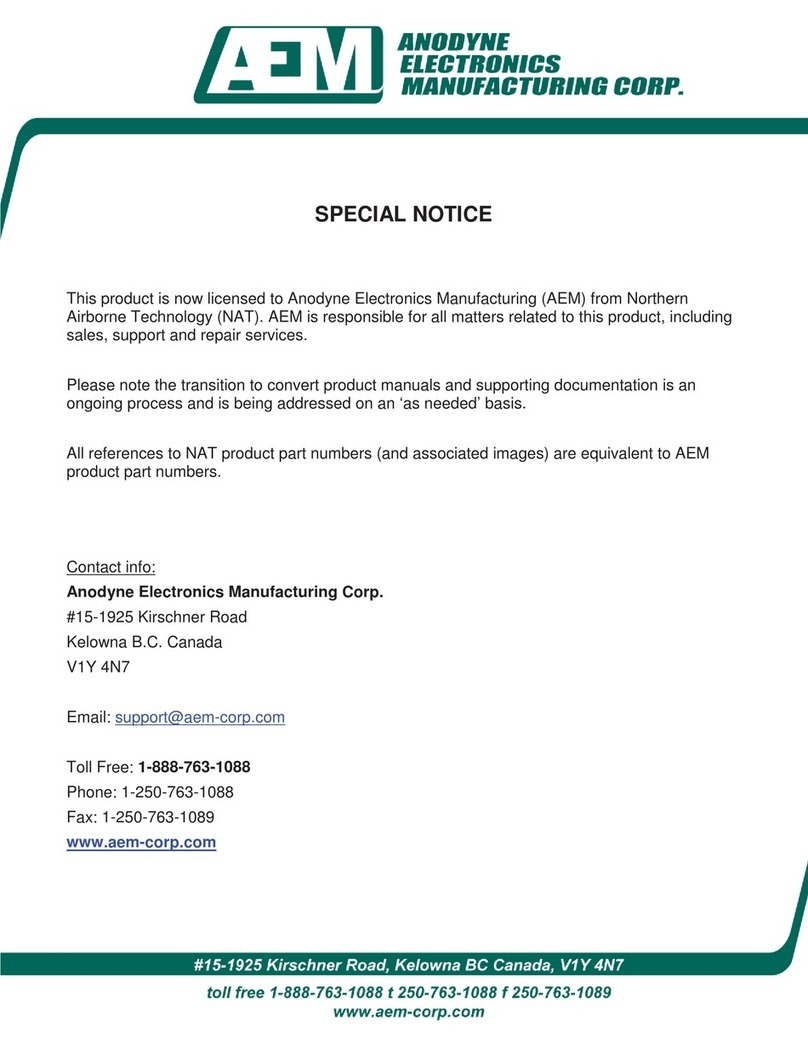
AEM
AEM SM19 Installation and operation manual

Dedenbear
Dedenbear Thunder T1 Installation & operation manual
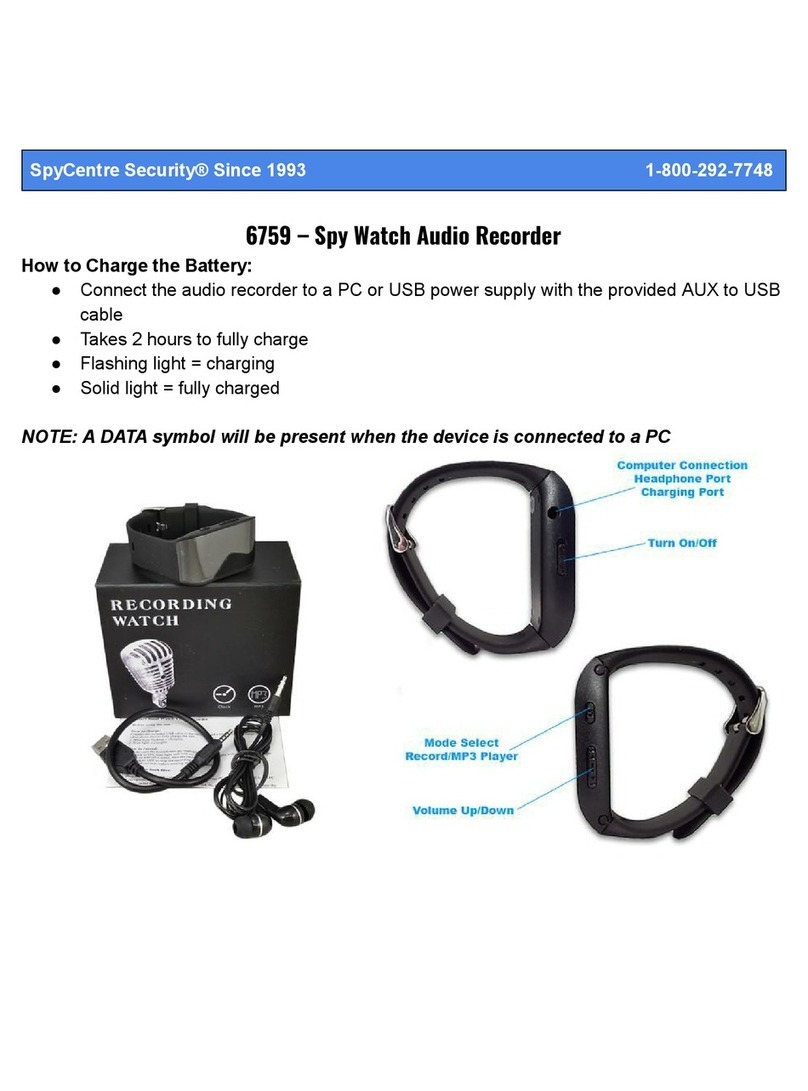
Spycentre Security
Spycentre Security 6759 quick start guide
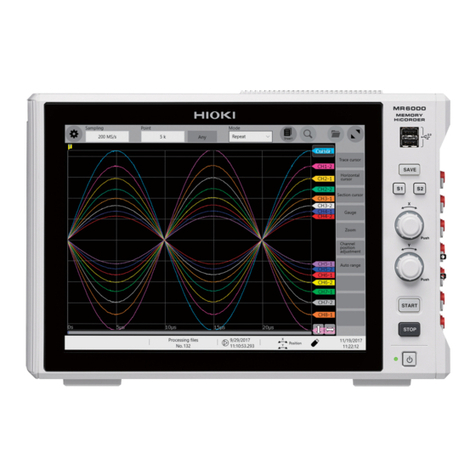
Hioki
Hioki Memory HiCorder MR6000 Quick start manual
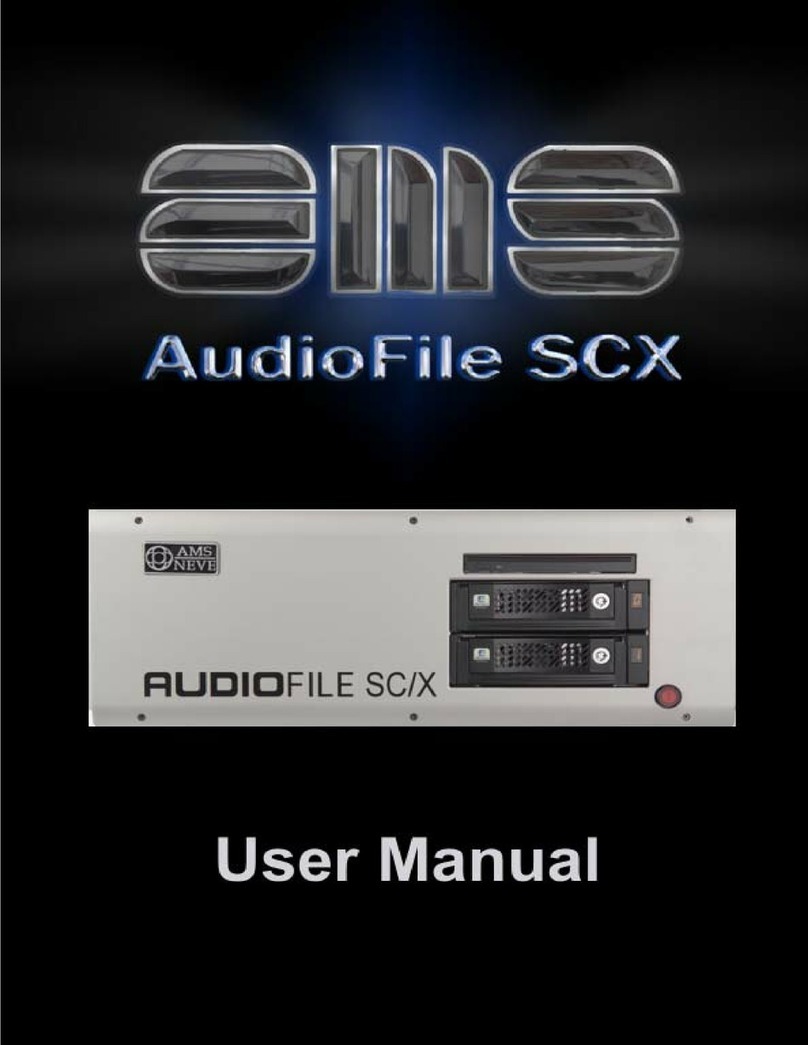
AMS Neve
AMS Neve AudioFile SC/X user manual
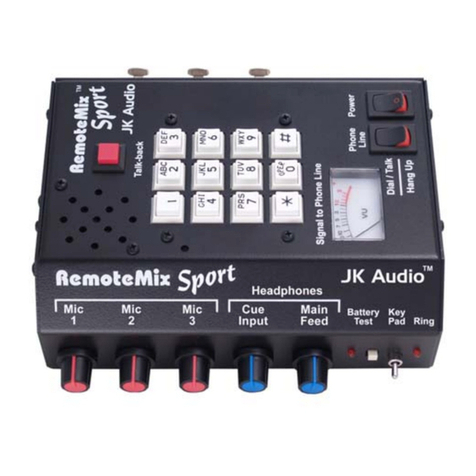
JK Audio
JK Audio RemoteMix Sport user guide
